Machine Learning for Detection of Macroalgal Blooms in the Mar Menor Coastal Lagoon Using Sentinel-2
Abstract
1. Introduction
2. Materials and Methods
2.1. In Situ Information
2.2. Sentinel-2 Satellite Data Preprocessing
2.3. Machine Learning Algorithms
2.3.1. Clustering
2.3.2. Classification
2.3.3. Evaluation Metrics
3. Results and Discussion
3.1. Chlorophyll Analysis in Areas of Interest
3.2. Clustering
3.3. Classification
3.4. Algorithm Explainability: SHAP Values to Understand Input Relevance in Output
3.5. Probability of a Macroalgal Bloom
3.6. Prediction of Future Macroalgal Blooms
4. Conclusions
Author Contributions
Funding
Data Availability Statement
Acknowledgments
Conflicts of Interest
References
- Pérez Ruzafa, Á.; Marcos Diego, C.; Gilabert Cervera, F.J. The Ecology of the Mar Menor Coastal Lagoon: A Fast Changing Ecosystem under Human Pressure; CRC Press: Boca Raton, FL, USA, 2005; pp. 392–422. [Google Scholar]
- Ruiz-Fernández, J.M.; León, V.; Marín-Guirao, L.; Giménez-Casaduero, F.; Rogel, J.; Esteve-Selma, M.; Martínez-Fernández, J. Synthesis report of the current state of Mar Menor lagoon and its causes in relation to the nutrient contents. In Technical Report Informe de Asesoramiento Técnico del Instituto Español de Oceanografía (IEO); Instituto Español de Oceanografía (IEO): Murcia, Spain, 2019; p. 24. [Google Scholar]
- García-Pintado, J.; Martínez-Mena, M.; Barberá, G.; Albaladejo, J. Anthropogenic nutrient sources and loads from a Mediterranean catchment into a coastal lagoon: Mar Menor, Spain. Sci. Total Environ. 2007, 373, 220–239. [Google Scholar] [CrossRef]
- Caballero, I.; Ruiz, J.; Navarro, G. Sentinel-2 Satellites Provide Near-Real Time Evaluation of Catastrophic Floods in the West Mediterranean. Water 2019, 11, 2499. [Google Scholar] [CrossRef]
- Erena, M.; Domínguez, J.A.; Aguado-Giménez, F.; Soria, J.; García-Galiano, S. Monitoring Coastal Lagoon Water Quality through Remote Sensing: The Mar Menor as a Case Study. Water 2019, 11, 1468. [Google Scholar] [CrossRef]
- Ruiz-Fernández, J.M.; Clemente-Navarro, P.; Mercado, J.M.; Fraile-Nuez, E.; Albentosa, M.; Marín-Guirao, L.; Santos, J. Nuevo evento de mortalidad masiva de organismos marinos en el Mar Menor: Contexto y factores. In Informe de Asesoramiento Técnico del Instituto Español de Oceanografía (IEO); Instituto Español de Oceanografía (IEO): Murcia, Spain, 2021; p. 24. [Google Scholar]
- Chen, J.; Zhu, W.; Tian, Y.Q.; Yu, Q. Monitoring dissolved organic carbon by combining Landsat-8 and Sentinel-2 satellites: Case study in Saginaw River estuary, Lake Huron. Sci. Total Environ. 2020, 718, 137374. [Google Scholar] [CrossRef]
- Erena, M.; Domínguez, J.A.; Atenza, J.F.; García-Galiano, S.; Soria, J.; Pérez-Ruzafa, Á. Bathymetry Time Series Using High Spatial Resolution Satellite Images. Water 2020, 12, 531. [Google Scholar] [CrossRef]
- Cao, F.; Tzortziou, M. Capturing dissolved organic carbon dynamics with Landsat-8 and Sentinel-2 in tidally influenced wetland–estuarine systems. Sci. Total Environ. 2021, 777, 145910. [Google Scholar] [CrossRef]
- Caballero, I.; Roca, M.; Santos-Echeandía, J.; Bernárdez, P.; Navarro, G. Use of the Sentinel-2 and Landsat-8 Satellites for Water Quality Monitoring: An Early Warning Tool in the Mar Menor Coastal Lagoon. Remote Sens. 2022, 14, 2744. [Google Scholar] [CrossRef]
- Guiry, M.D.; Guiry, G.M. AlgaeBase. World-Wide Electronic Publication. National University of Ireland, Galway. Available online: https://www.algaebase.org (accessed on 1 September 2022).
- Valle, M.; Pala, V.; Lafon, V.; Dehouck, A.; Garmendia, J.M.; Borja, A.; Chust, G. Mapping estuarine habitats using airborne hyperspectral imagery, with special focus on seagrass meadows. Estuar. Coast. Shelf Sci. 2015, 164, 433–442. [Google Scholar] [CrossRef]
- Caballero, I.; Fernández, R.; Escalante, O.M.; Mamán, L.; Navarro, G. New capabilities of Sentinel-2A/B satellites combined with in situ data for monitoring small harmful algal blooms in complex coastal waters. Sci. Rep. 2020, 10, 8743. [Google Scholar] [CrossRef]
- León-Pérez, M.C.; Armstrong, R.A.; Hernández, W.J.; Aguilar-Perera, A.; Thompson-Grim, J. Seagrass cover expansion off Caja de Muertos Island, Puerto Rico, as determined by long-term analysis of historical aerial and satellite images (1950–2014). Ecol. Indic. 2020, 117, 106561. [Google Scholar] [CrossRef]
- Rodríguez-Benito, C.V.; Navarro, G.; Caballero, I. Using Copernicus Sentinel-2 and Sentinel-3 data to monitor harmful algal blooms in Southern Chile during the COVID-19 lockdown. Mar. Pollut. Bull. 2020, 161, 111722. [Google Scholar] [CrossRef]
- Yang, Z.; Yu, X.; Dedman, S.; Rosso, M.; Zhu, J.; Yang, J.; Wang, J. UAV remote sensing applications in marine monitoring: Knowledge visualization and review. Sci. Total Environ. 2022, 838, 155939. [Google Scholar] [CrossRef]
- Page, B.P.; Olmanson, L.G.; Mishra, D.R. A harmonized image processing workflow using Sentinel-2/MSI and Landsat-8/OLI for mapping water clarity in optically variable lake systems. Remote Sens. Environ. 2019, 231, 111284. [Google Scholar] [CrossRef]
- Zhang, X.; Fichot, C.G.; Baracco, C.; Guo, R.; Neugebauer, S.; Bengtsson, Z.; Ganju, N.; Fagherazzi, S. Determining the drivers of suspended sediment dynamics in tidal marsh-influenced estuaries using high-resolution ocean color remote sensing. Remote Sens. Environ. 2020, 240, 111682. [Google Scholar] [CrossRef]
- O’Reilly, J.E.; Maritorena, S.; Mitchell, B.G.; Siegel, D.A.; Carder, K.L.; Garver, S.A.; Kahru, M.; McClain, C. Ocean color chlorophyll-a algorithms for SeaWiFS, OC2 and OC4. In SeaWiFS Postlaunch, Calibration and Validation Analyses: Part 3; Hooker, S.B., Firestone, E.R., Eds.; NASA Goddard Space Flight Center: Greenbelt, MD, USA, 2000; pp. 9–23. [Google Scholar]
- Mishra, S.; Mishra, D.R. Normalized difference chlorophyll index: A novel model for remote estimation of chlorophyll-a concentration in turbid productive waters. Remote Sens. Environ. 2012, 117, 394–406. [Google Scholar] [CrossRef]
- Gorelick, N.; Hancher, M.; Dixon, M.; Ilyushchenko, S.; Thau, D.; Moore, R. Google Earth Engine: Planetary-Scale geospatial analysis for everyone. Remote Sens. Environ. 2017, 202, 18–27. [Google Scholar] [CrossRef]
- Lloyd, S. Least squares quantization in PCM. IEEE Trans. Inf. Theory 1982, 28, 129–137. [Google Scholar] [CrossRef]
- Caliński, T.; Harabasz, J. A dendrite method for cluster analysis. Commun. Stat. 1974, 3, 1–27. [Google Scholar] [CrossRef]
- Wu, X.; Kumar, V.; Ross Quinlan, J.; Ghosh, J.; Yang, Q.; Motoda, H.; McLachlan, G.J.; Ng, A.; Liu, B.; Yu, P.S.; et al. Top 10 algorithms in data mining. Knowl. Inf. Syst. 2008, 14, 1–37. [Google Scholar] [CrossRef]
- Blagus, R.; Lusa, L. Class prediction for high-dimensional class-imbalanced data. BMC Bioinform. 2010, 11, 523. [Google Scholar] [CrossRef]
- Powers, D.M.W. Evaluation: From precision, recall and F-measure to ROC, informedness, markedness & correlation. J. Mach. Learn. Technol. 2011, 2, 37–63. [Google Scholar]
- Jurman, G.; Riccadonna, S.; Furlanello, C. A comparison of MCC and CEN error measures in multi-class prediction. PLoS ONE 2012, 7, 41882. [Google Scholar] [CrossRef]
- Stehman, S. Selecting and interpreting measures of thematic classification accuracy. Remote Sens. Environ. 1997, 62, 77–89. [Google Scholar] [CrossRef]
- Cartagena, U.P. Servidor de Datos Científicos del Mar Menor. Available online: https://marmenor.upct.es/ (accessed on 12 August 2022).
- Molnar, C. Interpretable Machine Learning. A Guide for Making Black Box Models Explainable. Available online: https://christophm.github.io/interpretable-ml-book/shap.html (accessed on 20 June 2022).
- Roca, M.; Dunbar, M.B.; Roman, A.; Caballero, I.; Zoffoli, M.L.; Gernez, P.; Navarro, G. Monitoring the marine invasive alien species Rugulopteryx okamurae using unmanned aerial vehicles and satellites. Front. Mar. Sci. 2022, 9, 1004012. [Google Scholar] [CrossRef]
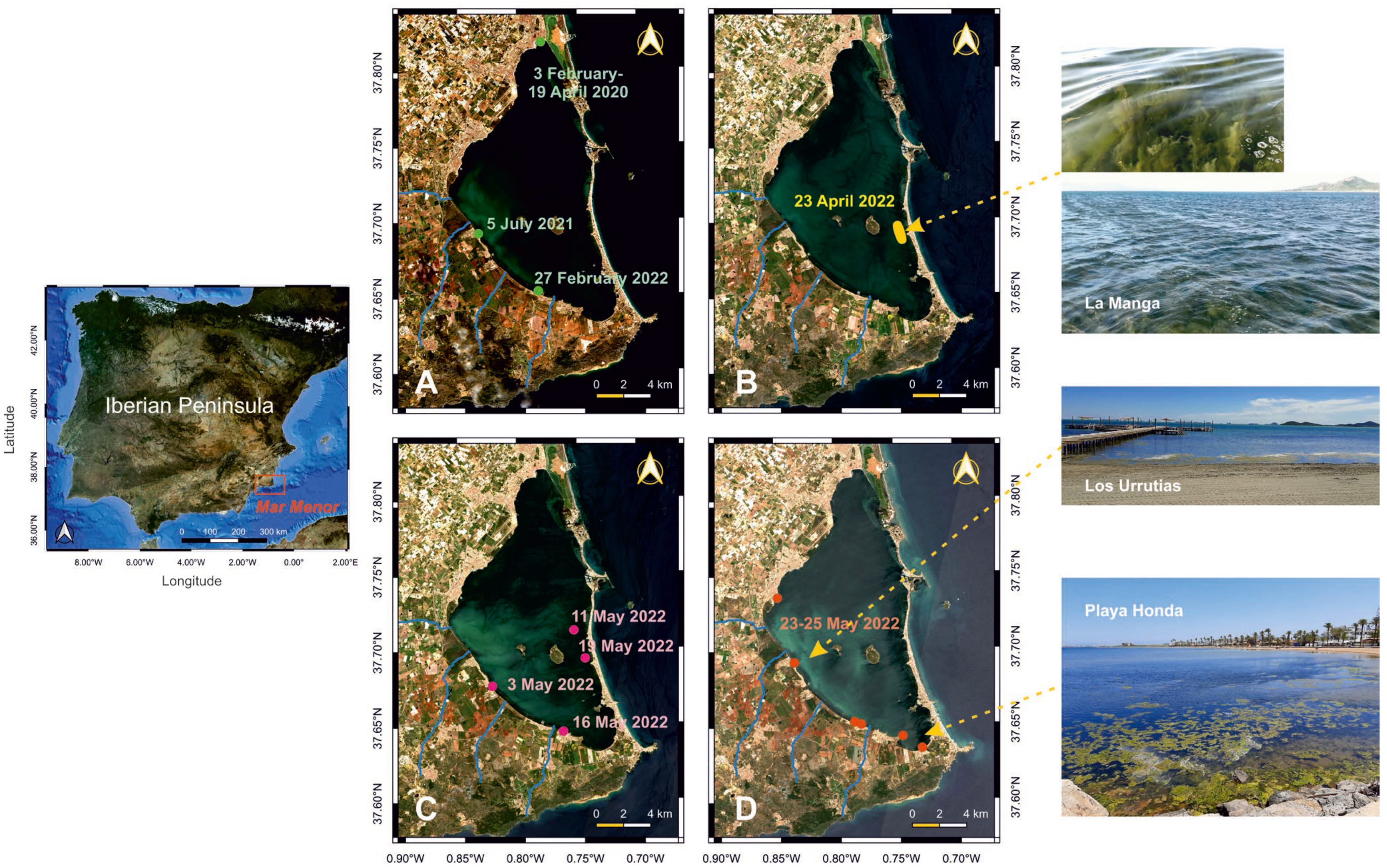
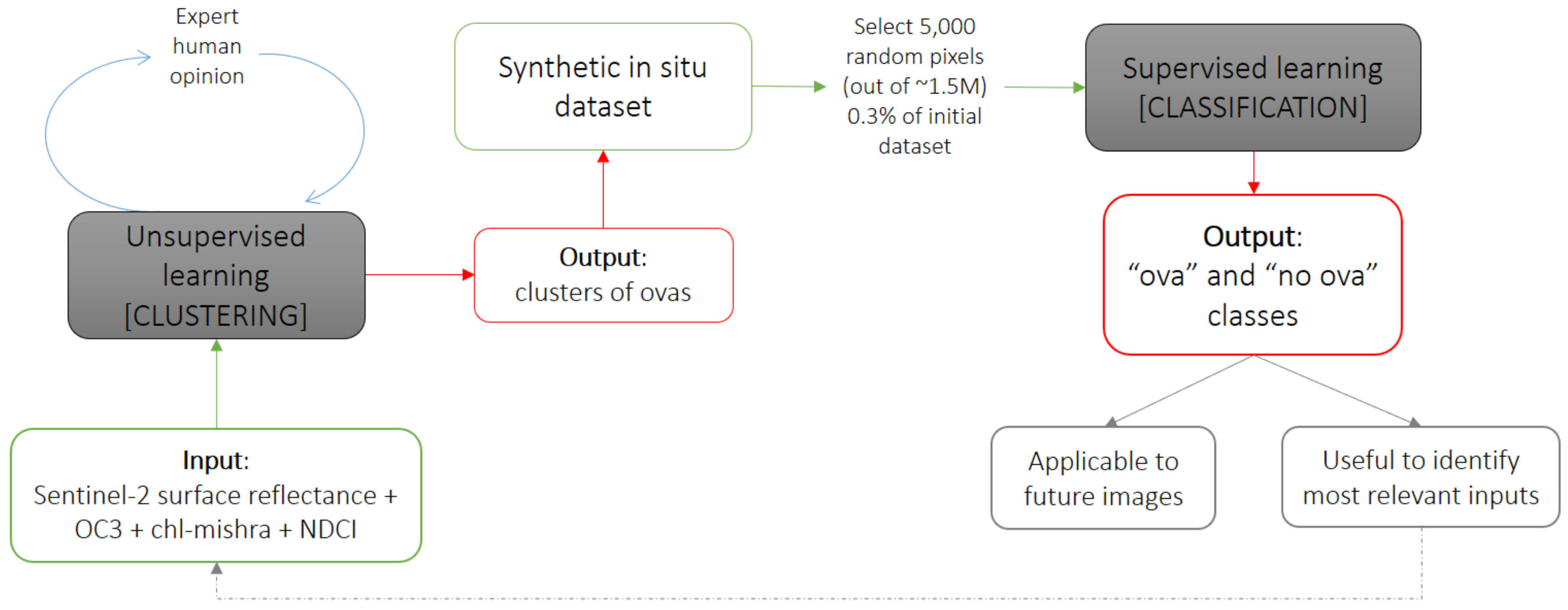

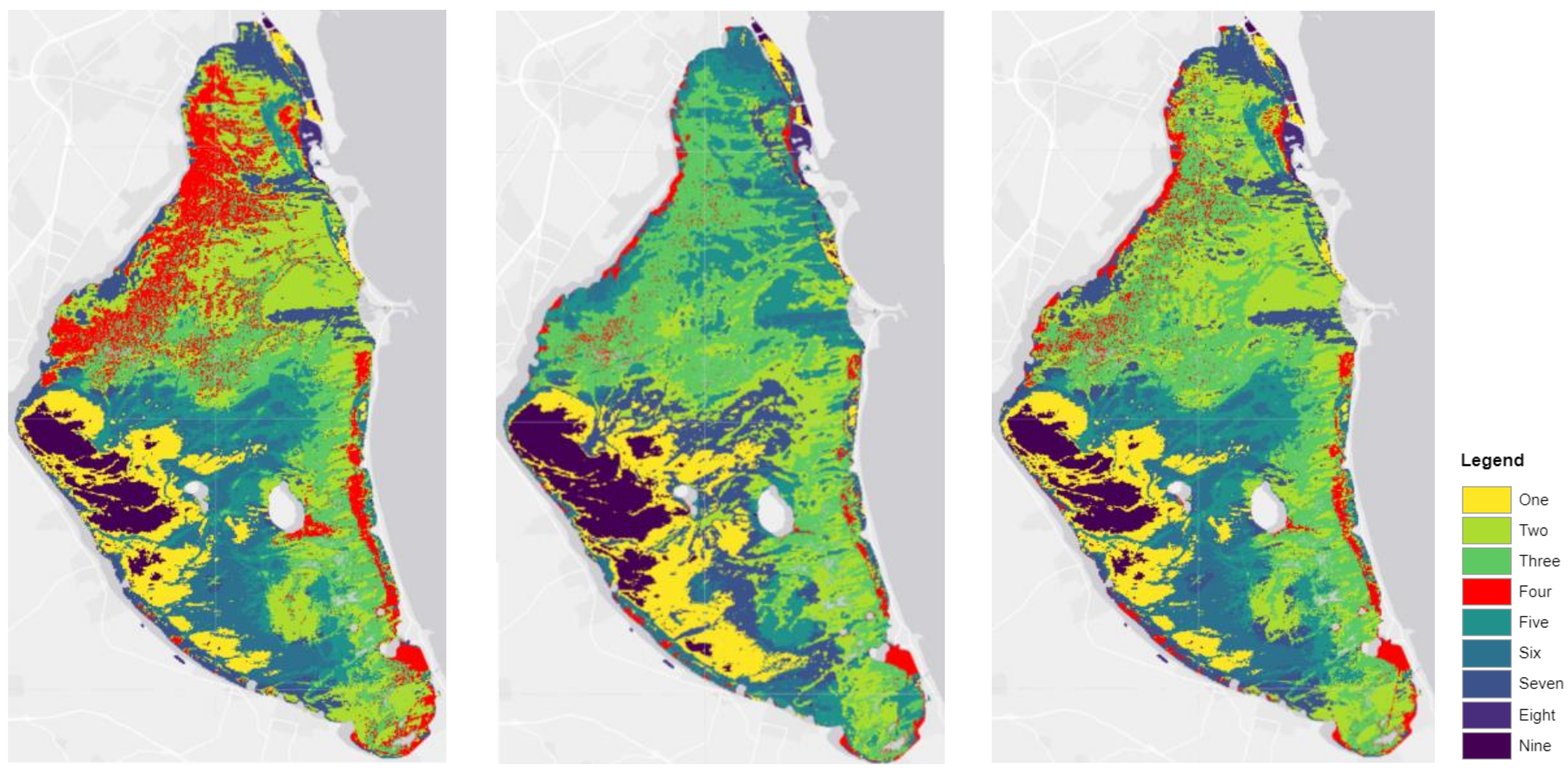
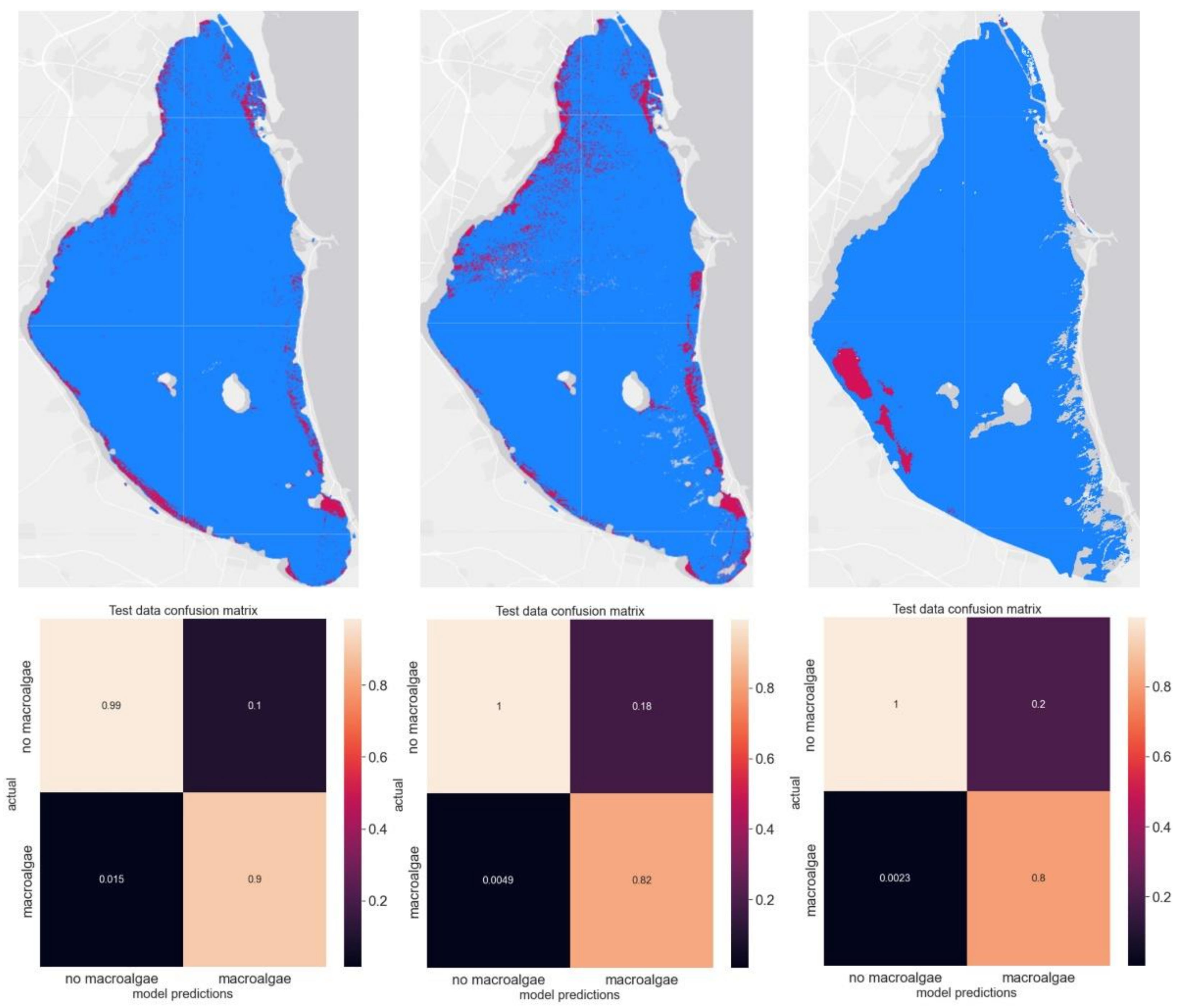


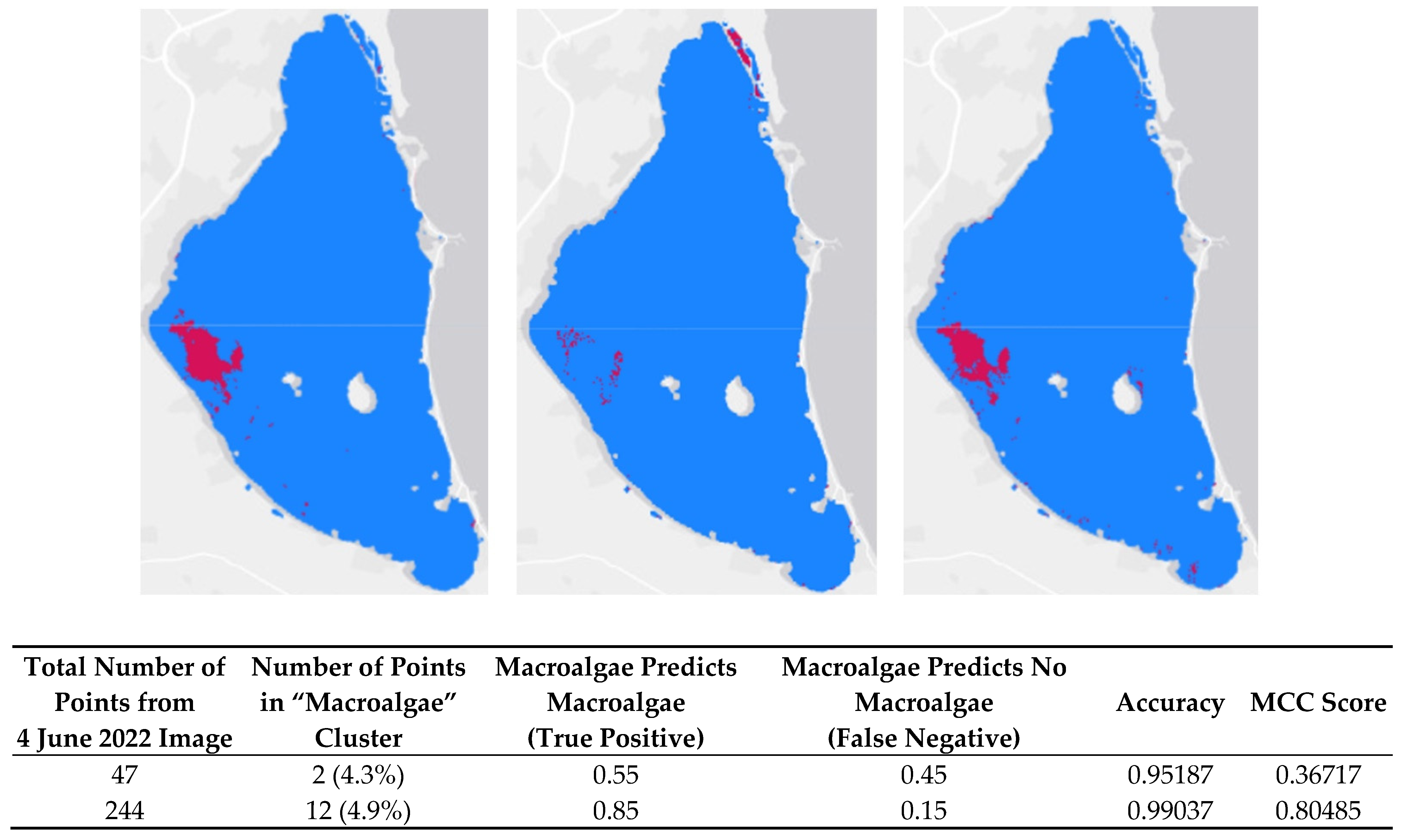
| Date | Latitude (N) | Longitude | Source |
|---|---|---|---|
| 3 February 2020 | 37.818518 | −0.780308 | Newspapers |
| 14 February 2020 | 37.818518 | −0.780308 | Newspapers |
| 25 May 2020 | 37.818518 | −0.780308 | Fishermen |
| 2 April 2020 | 37.818518 | −0.780308 | Newspapers |
| 19 April 2020 | 37.818518 | −0.780308 | Fishermen |
| 5 July 2021 | 37.692149 | −0.835999 | Sampling campaign |
| 27 February 2022 | 37.653302 | −0.787118 | Sampling campaign |
| 23 April 2022 | 37.695776 | −0.749627 | Fishermen |
| 23 April 2022 | 37.686675 | −0.746365 | Newspapers |
| 3 May 2022 | 37.676429 | −0.824669 | Sampling campaign |
| 11 May 2022 | 37.712459 | −0.7555 | Sampling campaign |
| 16 May 2022 | 37.645719 | −0.766202 | Sampling campaign |
| 19 May 2022 | 37.693689 | −0.746672 | Sampling campaign |
| 23 May 2022 | 37.642472 | −0.746724 | Sampling campaign |
| 25 May 2022 | 37.652301 | −0.786721 | Sampling campaign |
| 25 May 2022 | 37.650738 | −0.781142 | Sampling campaign |
| 25 May 2022 | 37.692027 | −0.835934 | Sampling campaign |
| 25 May 2022 | 37.634358 | −0.730684 | Sampling campaign |
Disclaimer/Publisher’s Note: The statements, opinions and data contained in all publications are solely those of the individual author(s) and contributor(s) and not of MDPI and/or the editor(s). MDPI and/or the editor(s) disclaim responsibility for any injury to people or property resulting from any ideas, methods, instructions or products referred to in the content. |
© 2023 by the authors. Licensee MDPI, Basel, Switzerland. This article is an open access article distributed under the terms and conditions of the Creative Commons Attribution (CC BY) license (https://creativecommons.org/licenses/by/4.0/).
Share and Cite
Medina-López, E.; Navarro, G.; Santos-Echeandía, J.; Bernárdez, P.; Caballero, I. Machine Learning for Detection of Macroalgal Blooms in the Mar Menor Coastal Lagoon Using Sentinel-2. Remote Sens. 2023, 15, 1208. https://doi.org/10.3390/rs15051208
Medina-López E, Navarro G, Santos-Echeandía J, Bernárdez P, Caballero I. Machine Learning for Detection of Macroalgal Blooms in the Mar Menor Coastal Lagoon Using Sentinel-2. Remote Sensing. 2023; 15(5):1208. https://doi.org/10.3390/rs15051208
Chicago/Turabian StyleMedina-López, Encarni, Gabriel Navarro, Juan Santos-Echeandía, Patricia Bernárdez, and Isabel Caballero. 2023. "Machine Learning for Detection of Macroalgal Blooms in the Mar Menor Coastal Lagoon Using Sentinel-2" Remote Sensing 15, no. 5: 1208. https://doi.org/10.3390/rs15051208
APA StyleMedina-López, E., Navarro, G., Santos-Echeandía, J., Bernárdez, P., & Caballero, I. (2023). Machine Learning for Detection of Macroalgal Blooms in the Mar Menor Coastal Lagoon Using Sentinel-2. Remote Sensing, 15(5), 1208. https://doi.org/10.3390/rs15051208







